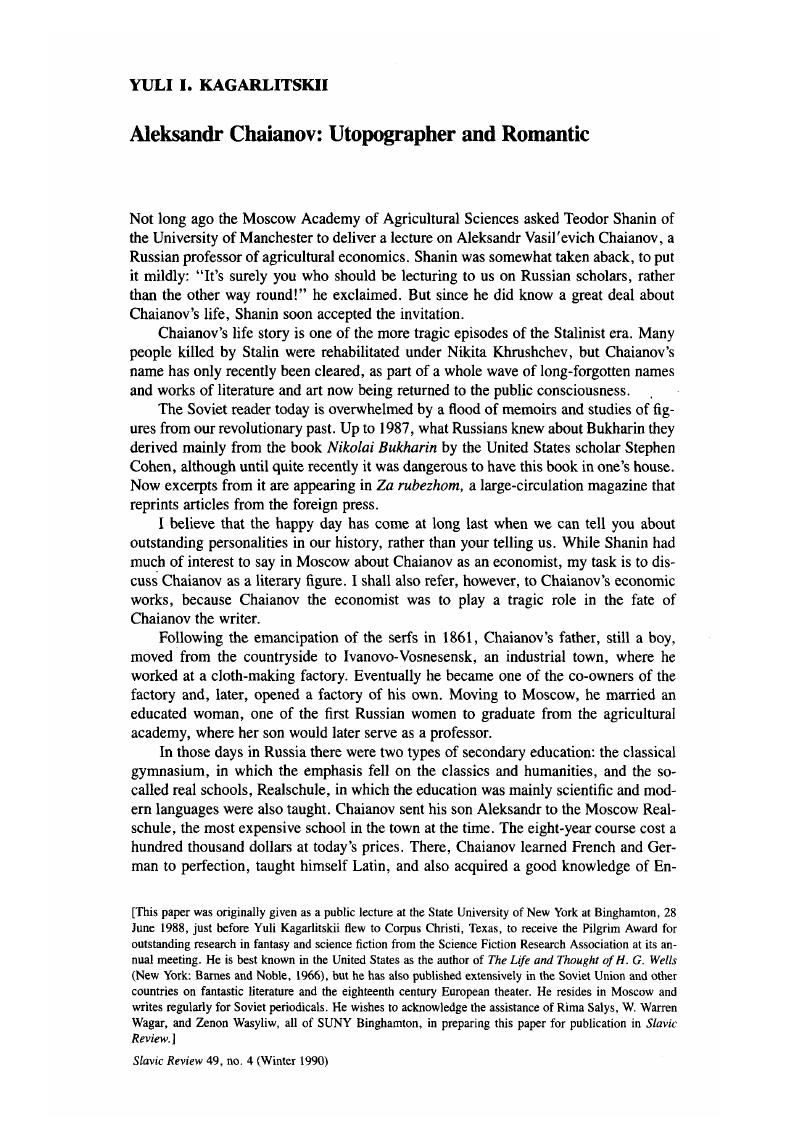Article contents
Aleksandr Chaianov: Utopographer and Romantic
Published online by Cambridge University Press: 27 January 2017
Abstract

- Type
- Notes and Comments
- Information
- Copyright
- Copyright © Association for Slavic, East European, and Eurasian Studies. 1990
References
This paper was originally given as a public lecture at the State University of New York at Binghamton, 28 June 1988, just before Yuli Kagarlitskii flew to Corpus Christi, Texas, to receive the Pilgrim Award for outstanding research in fantasy and science fiction from the Science Fiction Research Association at its annual meeting. He is best known in the United States as the author of The Life and Thought ofH. G. Wells (New York: Barnes and Noble, 1966), but he has also published extensively in the Soviet Union and other countries on fantastic literature and the eighteenth century European theater. He resides in Moscow and writes regularly for Soviet periodicals. He wishes to acknowledge the assistance of Rima Salys, W. Warren Wagar, and Zenon Wasyliw, all of SUNY Binghamton, in preparing this paper for publication in Slavic Review.
1. Evidence of the widespread interest in Chaianov in the Soviet Union today is also provided by the many articles on his life and work appearing in journals and newspapers, such as the following : Gavrichkin, V, “Aleksandr Chaianov—grazhdanin i uchenyi, ” hvestiia 29, no. 1 (1988)Google Scholar; Vladimir Vasil'evich Kabanov, “Aleksandr Vasil'evich Chaianov, ” Voprosy istorii, no. 6 (June 1988) : 146-167; Konovalov, V, “Otkrytie Chaianova, ” Komsomolskaia pravda 29, no. 1 (1988)Google Scholar; Miasoedov, B, “Kto takoi Chaianov, ” Knizhnoe obozrenie 22, no. 1 (1988)Google Scholar; P. Penezhko, “Kak udarili po ‘chaianovshchine', ” Ogonek, no. 10 (1988); and Zaraev, M, “Chytaia Chaianova, ” Selskaia zhizn’ 16, no. 1 (1988)Google Scholar. In the third quarter of 1989, Sovremennik in Moscow is scheduled to reprint Chaianov's Venetsianskoe zerkalo, Hi udivitel'nye pokhozhdeniia stekliannogo cheloveka.
2. An introduction to Chaianov's work in English translation is available in The Theory of Peasant Economy (Homewood, 111. : Irwin, 1966), ed. Daniel Thorner, Basile Kerblay, and R. E. F. Smith. This book contains two of Chaianov's economic treatises from the 1920s, as well as articles on the author's thought and life by Thorner and by Kerblay, and a comprehensive bibliography of his writings. See also Teodor, Shanin, “The Nature and Logic of the Peasant Economy, ” Journal of Peasant Studies 1 (October 1973) : 63–80 and (January 1974) : 184-206Google Scholar; and Utsa, Patnaik, “Neo-Populism and Marxism : The Chayanovian View of the Agrarian Question and Its Fundamental Fallacy, ” Journal of Peasant Studies 6 (July 1979) : 375–420Google Scholar. An English translation of Puteshestvie moego brata appears in The Russian Peasant, 1920 and 1984, ed. R. E. F. Smith (London : Frank Cass, 1977), 63-116. The translation is by T. M. Myskow and Smith.
3. Iv. Kremnev [Aleksandr Chaianov], Puteshestvie moego brata Alekseia v stranu krest'ianskoi utopii. Chast’ I, Intro. P. Orlovskii [pseud, of V. Vorovskii] : 30.
- 1
- Cited by




